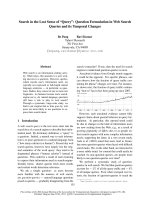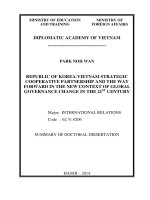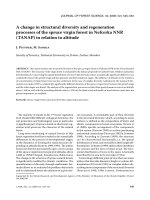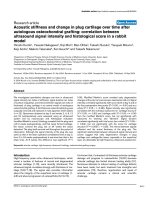Phonetics and philology: sound change in italic
Bạn đang xem bản rút gọn của tài liệu. Xem và tải ngay bản đầy đủ của tài liệu tại đây (3.76 MB, 295 trang )
Tai ngay!!! Ban co the xoa dong chu
Phonetics and Philology
This page intentionally left blank
Phonetics and Philology
Sound Change in Italic
JANE STUART-SMITH
OXFORD
UNIVERSITY PRESS
OXFORD
UNIVERSITY PRESS
Great Clarendon Street, Oxford OX2 6DP
Oxford University Press is a department of the University of Oxford.
It furthers the University's objective of excellence in research, scholarship,
and education by publishing worldwide in
Oxford New York
Auckland Bangkok Buenos Aires Cape Town Chennai
Dar es Salaam Delhi Hong Kong Istanbul Karachi Kolkata
Kuala Lumpur Madrid Melbourne Mexico City Mumbai Nairobi
Sao Paulo Shanghai Taipei Tokyo Toronto
Oxford is a registered trade mark of Oxford University Press
in the UK and in certain other countries
Published in the United States
by Oxford University Press Inc., New York
© Jane Stuart-Smith 2004
The moral rights of the author have been asserted
Database right Oxford University Press (maker)
First published 2004
All rights reserved. No part of this publication may be reproduced,
stored in a retrieval system, or transmitted, in any form or by any means,
without the prior permission in writing of Oxford University Press,
or as expressly permitted by law, or under terms agreed with the appropriate
reprographics rights organization. Enquiries concerning reproduction
outside the scope of the above should be sent to the Rights Department,
Oxford University Press, at the address above
You must not circulate this book in any other binding or cover
and you must impose this same condition on any acquirer
British Library Cataloguing in Publication Data
Data available
Library of Congress Cataloging in Publication Data
Data available
ISBN 0-19-9257736
1 3 5 7 9 1 08 6 4 2
Typeset by Newgen Imaging Systems (P) Ltd., Chennai, India
Printed in Great Britain on acid-free paper by
Biddies Ltd. www.biddles.co.uk.
For my parents
This page intentionally left blank
Preface
The seeds of this book were sown in the first Comparative Philology lectures
I attended given by Paddy Considine in 1985 as part of my first degree in Classics
at University College London. As Paddy outlined the basic ideas behind
comparative reconstruction and Proto-Indo-European, I wondered then about
exactly what these reconstructions might have sounded like, and how they could
have changed into the sounds attested, albeit indirectly, in the ancient inscriptions of Greek and Latin. Four years later I started the M.Phil. in Comparative
Philology and General Linguistics at Oxford University, and had the good fortune to attend my first Phonetics lectures given by Bruce Connell, a phonetician
with a keen interest in the phonetics of sound change, who introduced me to
John Ohala and his phonetic model of sound change. From then on, I became
determined to try to understand better the mechanisms of reconstructed sound
change by considering and applying the findings of contemporary phonetic
research. Apart from the exceptional work of W. S. Allen, both a distinguished
philologist and a trained phonetician, who gracefully links the two, as in his
classic book on the pronunciation of Latin, Vox Latina, detailed and informed
phonetic discussion tends to be absent from philology. The selection of 'Italic' as
my major language group for the M.Phil. naturally led me to encounter the
development of the voiced aspirates, and my quest for a resolution to the old
debate began. I tackled it first in my M.Phil. thesis, and then again in my D.Phil.,
which was the basis for this book. For most of my doctoral research I was largely
an 'observer' of phonetic research, in that I studied the subject keenly and
carried out odd bits of informal auditory and acoustic analysis. Only once I had
finished my thesis did I start gathering my own recordings and carrying out
systematic instrumental phonetic analysis, first on Panjabi. I then moved on to a
long-term study of the accent of Glasgow. As I wrote the book my own personal
experience as a phonetician confirmed the ideas I had once had, and enabled me
to develop them further. Indeed my current research on variation and change in
Glaswegian consonants demonstrates a range and complexity of variation which
will inevitably inform models of reconstructed changes for consonants proposed
by those working in philology.
The book started life as a thesis, and one that bridged two disciplines,
phonetics and philology. I therefore have a number of people to thank for helping
me at that stage of the work: John Penney, my 'main' supervisor, for careful
reading and wise advice; John Coleman, for phonetic discussion, encouragement
and enthusiasm; Bruce Connell, for a careful and systematic introduction to the
phonetics of sound change, and Anna Morpurgo Davies, for engaged and lively
discussion of the main issues. I also benefited from discussions and feedback
viii
Preface
from phoneticians interested in sound change, and in particular with Paul
Foulkes, Tore Janson, and John Ohala. My two examiners, David Langslow and
Katrina Hayward, were keen and enthusiastic critics. Both provided me with
support and detailed feedback, and I was very happy that David agreed to read
the book once again in draft and offer more advice. At the same time I am very
sad that Katrina will not see the finished volume.
When I took up my post at Glasgow my intrepid colleagues Jeremy Smith and
Christian Kay read the thesis and urged me to publish it. Once the book was in
draft I was very fortunate to have comments from two anonymous readers for
the Press, and from the following readers: Paul Foulkes, Brian Joseph, Joshua
Katz, Gerhard Meiser, John Penney, Helmut Rix, Jürgen Untermann and Rex
Wallace. It was particularly encouraging for me to have such a positive response
from Helmut Rix, and from his colleagues, Jürgen Untermann and Gerhard
Meiser, all of whom have done so much to extend our understanding of Italic.
I have received financial support at different stages of this work. My postgraduate work was funded by the British Academy, and supported by Christ
Church, my first college. I subsequently received a Levick Sisters' Senior
Scholarship from Somerville College, together with generous grants towards
conference attendance. The Committee for Comparative Philology and General
Linguistics, the Oxford University Phonetics Laboratory, and the University of
Oxford also provided financial support for this purpose. I was able to see many
of the inscriptions during a research visit to Italy in the autumn of 1992. This
would not have been possible without the generous support of the British School
of Rome, the Craven Committee, and the University of Oxford. Anna Sommella
and the late Alessandro Vaciago were instrumental in helping me to access many
of the materials there. More recently, the Arts and Humanities Research Board
has helped considerably, but inadvertently, by awarding me a grant for research
leave during which I was able to devote my time to writing and completing
the book.
I have also received a great deal of personal support. During my graduate
days, I was fortunate in my student friends, and in particular in Stephen Colvin,
Eleanor Dickey, Niall Livingstone, Philomen Probert and Jason Zerdin, some of
whom know far too much about the voiced aspirates and their development in
Italic. When I considered applying to the Department of English Language at
Glasgow, I was told by several that it was the friendliest department in the
country. I can vouch that this is indeed true. All of my colleagues in the
Department of English Language have been supportive in their own ways, but
Eleanor Lawson has to be thanked for helping with the scanning, Katie Lowe for
coffee at just the right time, Simon Horobin for patiently listening to reports of
how it was all going, and Mike MacMahon for being a very understanding Head
of Department. I must also mention all those involved at Oxford University
Press, Henry Miller, and Virginia Masardo for speedy yet careful copy-editing,
and especially my patient editor John Davey for waiting for so long to receive the
Preface
ix
manuscript. There was a good reason for the delay, or rather two good reasons,
in the form of Alexander and Max, who have made the final stages so much
more enjoyable. Finally, I thank my family for their love and support:
my parents-in-law, my parents, my sister and her family, and my husband,
Wolf-Gerrit Früh.
J. H. S-S
30 June 2003
This page intentionally left blank
Acknowledgements
I am very grateful to G. Bretschneider for permission to reproduce Figure 1 from
'L'iscrizione di Poggio Sommavilla', by A. Marinetti which appeared in Studi
Etruschi, 1985, volume 51, on page 169, and to Elsevier Science for allowing me to
reprint Figure 5 from 'Stop voicing in Hindi' by K. Davis which appeared in
Journal of Phonetics, 1994, Volume 22, on p186.
This page intentionally left blank
List of Abbreviations
1
2
3
abl.
acc.
adv.
Alb.
Arm.
Av.
Ben.
Cl.Arm.
CT
dat.
D
EBen.
ELat.
EM
EMG
Eng.
Etr.
f.
F0
Fal.
Fal.-Lat.
fut.
Gand.
GDp
gen.
Gk
Got.
Guj.
H.
Hary.
Hz
IA
INT
Iran.
imp.
first person
second person
third person
ablative
accusative
adverb
Albanian
Armenian
Avestan
Bengali
Classical Armenian
cricothyroid muscle
dative
Degrassi (1965)
Eastern Bengali
Early Latin
Ernout-Meillet (1979)
electromyography
English
Etruscan
feminine
fundamental frequency
Faliscan
Faliscan-Latin
future
Gandhari
Gandhari Dharmapada
genitive
Greek
Gothic
Gujarati
Hindi
Haryanvi
Hertz
Indo-Aryan
interarytenoid muscle
Iranian
imperative
xiv
Lat.
LCA
Lit.
LIV
LF
loc.
m.
Mar.
MIA
MIr.
ms
Nep.
neut.
NHG
NIA
nom.
O.
OCS
OE
OHG
OHern.
OHG
OIA
OIr.
OLat.
OLG
ON
OLD
OsGk
OsLat.
OsNat.
OU
OUmb.
OVols.
Pael.
Pan.
part.
pass.
PCA
perf.
PIE
Pk.
Pkt
List of Abbreviations
Latin
lateral cricoarytenoid muscle
Lithuanian
Rix (1998a)
Giacomelli (1963)
locative
masculine
Marathi
Middle Indo-Aryan
Middle Irish
milliseconds
Nepali
neuter
New High German
New Indo-Aryan
nominative
Oscan
Old Church Slavonic
Old English
Old High German
Old Hernican
Old High German
Old Indo-Aryan
Old Irish
Old Latin
Old Low German
Old Norse
Glare (1982)
Osco-Greek alphabet
Osco-Latin alphabet
Oscan native alphabet
Osco-Umbrian
Old Umbrian
Old Volscian
Paelignian
Panjabi
participle
passive
posterior cricoarytenoid muscle
perfect
Proto-Indo-European
Pokorny (1959)
Prakrit
List of Abbreviations
pl.
Plt.
Po
Port.
PrGk
PrIt.
PrLat.
pres.
Pros.
Ps
PS
Rom.
Russ.
Sab.
sg.
Skt
SPic.
subj.
TA
TI
U.
UmLat.
UmNat.
Uo
Ve
Vest.
voc.
VOC
VOT
WBen.
WH
YAv.
plural
Poultney
Poccetti (1979)
Portuguese
Proto-Greek
Proto-Italic
Proto-Latin
present
Prosdocimi
subglottal pressure
Presamnite
Romany
Russian
Sabellic
singular
Sanskrit
South Picene
subjunctive
thyroarytenoid muscle
Tabulae Iguvinae
Umbrian
Umbro-Latin alphabet
Umbrian native alphabet
oral air flow
Vetter (1953)
Vestinian
vocative
vocalis muscle
voice onset time
Western Bengali
Walde-Hofmann (1938)
Young Avestan
xv
Conventions
1 Representation of the voiced aspirates
The sounds which are central to this book may be transcribed in a number of
different ways, for example bh, the old philological convention; bh , the now
usual philological convention; [b], the phonetic transcription of the International Phonetic Alphabet (IPA 1996); [b h ], found in many phonetic texts, also
[bfi] and [bfi]. Here I use 'bh' either in italics to indicate a reconstructed form, or
with the appropriate brackets to indicate phonemes or allophones.
2
Fonts
I follow the usual philological conventions of giving reconstructed and attested
forms in italics. When referring to examples from inscriptions, italics are used to
indicate the Latin alphabet and bold text is used to indicate native alphabet.
3 Letters
I use angled brackets to indicate letters, and give Latin alphabet letters in
capitals, Greek alphabet letters in Greek alphabet, and native alphabet letters in
lower case. I use 8 to represent the Sabellic figure of eight symbol.
4
Texts
References to Faliscan texts are to the collections in Vetter (1953) and Giacomelli
(1963), with more recent inscriptions given according to first publication.
Sabellic texts are given as in Rix (2002). References to the Iguvine Tables (Um 1
in Rix 2002) are given without the preceding Um 1. Etruscan texts are given as in
Rix (1991).
5
Translations
In earlier work on Italic it was usual to translate Sabellic and Faliscan words into
Latin. This had the advantage of giving in one word core meaning, grammatical
form, and Latin cognate. It also presumed that the reader was familiar with
Conventions
xvii
Latin, and given that the interpretation of these texts is largely dependent on
formal correspondences with Latin, this was a reasonable assumption. Here I
give English translations for Sabellic and Faliscan, and supply in addition Latin
cognates. When translating names of gods and goddesses, I give the cognate
Latin name. The obscurity of many of the texts means that in many cases the
meanings of the words cited are far from certain. Thus most translations should
be regarded with some caution. For full interpretation, translation and grammatical parsing of all forms, I refer the reader to Vetter (1953) for Faliscan and
Untermann (2000) for Sabellic.
6
Sabellic vowels
When giving phonemic representations of Sabellic, I use /é/ for the close vowel
arising from *i and *e, and /ó/ for the corresponding close back vowel.
This page intentionally left blank
Contents
1 Introduction: Phonetics and Philology
1.1 Philology
1.2 Phonetics
1
4
6
2 The Italic Sound Change: Background
2.1 The PIE voiced aspirates
2.2 The Italic development
15
15
19
3 Philology: The Evidence for the Italic Development
3.1 The Italic evidence
3.2 The Italic scripts and the representation of /f/
3.2.1 The digraph FH
3.2.2 F and
3.2.3 Presamite<f>(Ps 20: Tortora)
3.2.4 The origins of 8
3.3 The evidence of Latin
3.3.1 The Latin alphabet
3.3.2 Latin: The lexical evidence
3.3.2.1 PIE *bh in Latin
3.3.2.2 PIE *dh in Latin
3.3.2.3 PIE *gh in Latin
3.3.2.4 PIE *gwh in Latin
3.3.3 Latin: From orthography to phonetics
3.3.3.1 /f/ in Latin
3.3.3.2 /h/ in Latin
3.3.3.3 The 'f/h' alternation in Latin
3.3.3.4 /b d/ in Latin
3.3.3.5 /g/ in Latin
3.3.3.6 /w/ in Latin
3.3.3.7 Before/after *r in Latin
3.3.3.8 Clusters with nasal in Latin
3.3.3.9 Clusters with *s in Latin
3.3.3.10 Clusters with *t in Latin
3.3.3.11 The treatment of *-s- in Latin
3.3.4 The development of the PIE voiced aspirates in Latin
3.4 The evidence of Faliscan
3.4.1 The writing systems of Faliscan
3.4.1.1 The Faliscan native alphabet
30
30
33
36
36
37
37
40
40
41
41
41
43
44
45
45
47
48
49
50
50
50
51
51
51
52
53
54
55
55
xx
Contents
3.4.1.2 The Faliscan-Latin alphabet
3.4.2 Faliscan: The lexical evidence
3.4.2.1 PIE *bh in Faliscan
3.4.2.2 PIE *dh in Faliscan
3.4.2.3 PIE *gh in Faliscan
3.4.2.4 PIE *gwh in Faliscan
3.4.3 Faliscan: from orthography to phonetics
3.4.3.1 /f/ in Faliscan
3.4.3.2 /h/ in Faliscan
3.4.3.3 The 'f/h' alternation in Faliscan
3.4.3.4 /g/ in Faliscan
3.4.3.5 Clusters with *t in Faliscan
3.4.3.6 The treatment of *-s- in Faliscan
3.4.4 The development of the PIE voiced aspirates in Faliscan
3.5 The evidence of the early Sabellic inscriptions
3.5.1 South Picene
3.5.1.1 The South Picene alphabet
3.5.1.2 South Picene: The orthographic evidence
3.5.1.2.1 PIE *bh in South Picene
3.5.1.2.2 PIE *dh in South Picene
3.5.1.2.3 PIE *gh in South Picene
3.5.1.2.4 PIE *gwh in South Picene
3.5.1.3 South Picene: from orthography to phonetics
3.5.1.3.1 /f/ in South Picene
3.5.1.3.2 /h/ in South Picene
3.5.1.3.3 The treatment of *-s- in South Picene
3.5.1.4 The development of the PIE voiced aspirates in South Picene
3.5.2 Presamnite
3.5.3 Old Umbrian
3.5.4 Old Volscian
3.5.5 Old Hernican
3.5.6 The development of the PIE voiced aspirates in the
early Sabellic inscriptions
3.6 The evidence of Oscan
3.6.1 The writing systems of Oscan
3.6.1.1 The Oscan native alphabet
3.6.1.2 The Osco-Greek alphabet
3.6.1.3 The Osco-Latin alphabet
3.6.2 Oscan: The lexical evidence
3.6.2.1 PIE *bh in Oscan
3.6.2.2 PIE *dh in Oscan
3.6.2.3 PIE *gh in Oscan
3.6.2.4 PIE *gwh in Oscan
55
56
56
56
58
58
59
59
60
61
62
62
63
63
64
65
66
66
66
67
68
68
68
68
70
71
71
71
73
76
76
77
77
78
78
78
79
79
79
81
83
84
Contents
3.6.3 Oscan : From orthography to phonetics
3.6.3.1 /f/ in Oscan
3.6.3.1.1 Oscan /f/: Orthography and pronunciation
3.6.3.1.2 Oscan /f/: Distribution and history
3.6.3.2 /h/ in Oscan
3.6.3.3 Clusters with *t in Oscan
3.6.3.4 Clusters with (sonant) nasal in Oscan
3.6.3.5 The treatment of *-s- in Oscan
3.6.4 The development of the PIE voiced aspirates in Oscan
3.7 The evidence of Umbrian
3.7.1 The writing systems of Umbrian
3.7.1.1 The Umbrian native alphabet
3.7.1.2 The Umbro-Latin alphabet
3.7.2 Umbrian: The lexical evidence
3.7.2.1 PIE *bh in Umbrian
3.7.2.2 PIE *dh in Umbrian
3.7.2.3 PIE *gh in Umbrian
3.7.2.4 PIE *gwh in Umbrian
3.7.3 Umbrian: From orthography to phonetics
3.7.3.1 /f/ in Umbrian
3.7.3.2 /h/ in Umbrian
3.7.3.3 Umbrian palatalization and *gh
3.7.3.4 Before/after *r in Umbrian
3.7.3.5 Clusters with nasal in Umbrian
3.7.3.6 Clusters with *s in Umbrian
3.7.3.7 Clusters with *t in Umbrian
3.7.3.8 The treatment of *-s- in Umbrian
3.7.4 The development of the PIE voiced aspirates in Umbrian
3.8 The evidence of the Minor Dialects
3.8.1 Paelignian
3.8.1.1 Paelignian: The lexical evidence
3.8.1.1.1 PIE *bh in Paelignian
3.8.1.1.2 PIE *dh in Paelignian
3.8.1.1.3 PIE *gh in Paelignian
3.8.1.1.4 PIE *gwh in Paelignian
3.8.1.2 Paelignian: From orthography to phonetics
3.8.1.2.1 /f/ in Paelignian
3.8.1.2.2 /h/ in Paelignian
3.8.1.2.3 The treatment of *-s- in Paelignian
3.8.1.3 The development of the PIE voiced aspirates in Paelignian
3.8.2 Marrucinian
3.8.3 Vestinian
3.8.4 Sabine
xxi
84
84
85
92
94
96
96
97
98
99
100
100
101
101
101
103
105
106
106
107
109
111
112
112
113
113
114
115
116
117
118
118
118
119
119
119
119
121
121
122
122
123
123
xxii
Contents
3.8.5
3.8.6
3.8.7
3.8.8
3.8.9
Aequian
Marsian
Hernican
Volscian
The development of the PIE voiced aspirates in the
Minor Dialects
3.9 External evidence
3.9.1 The evidence of Etruscan
3.9.1.1 /f/ in Etruscan
3.9.1.2 /h/ in Etruscan
3.9.1.3 Italic /h/ in Etruscan
3.9.1.4 Italic /f/ in Etruscan
3.9.2 The evidence of Greek
3.9.2.1 The representation of Italic in Greek
3.9.2.2 Italic /h/ in Greek
3.9.2.3 Italic /f/ in Greek
3.9.3 External evidence: Summary
3.10 The Italic reflexes: Summary
124
125
125
125
126
127
128
128
131
131
132
132
135
135
136
141
141
4 The Traditional Arguments Reviewed
4.1 The traditional arguments—internal
4.1.1 The Italic reflexes
4.1.2 Loanwords
4.1.3 Conditioned changes
4.1.3.1 The treatment of *-sdh- [-zdh-]
4.1.3.2 The treatment of *ghl-/ghr4.1.3.3 The treatment of voiced aspirates following a nasal
4.1.4 The treatment of PIE *-s4.2 The traditional arguments—external
4.2.1 Phonetic plausibility
4.2.1.1 Stated parallels
4.2.1.2 General beliefs about phonetic plausibility
4.2.2 Miscellaneous arguments
4.3 Summary and conclusions
144
146
146
147
150
150
152
153
154
155
155
156
157
158
158
5 Phonetics, Predictions, Parallels
5.1 Phonetics and predictions: The phonetics of Voiced aspirates'
5.1.1 Breathy voiced stops: Phonation
5.1.1.1 Phonation: Predictions for change
5.1.2 Breathy voiced stops: Articulation
5.1.2.1 Articulation: Predictions for change
5.1.3 Breathy voiced stops: Aerodynamic factors
5.1.3.1 Aerodynamic factors: Predictions for change
160
161
166
170
170
172
172
175
Contents
xxiii
5.1.4 Breathy voiced stops: Acoustics
5.1.4.1 Acoustics: Predictions for change
5.1.5 Breathy voiced stops: Perceptual cues
5.1.5.1 Perception: Predictions for change
5.1.6 Breathy voiced stops: Stress
5.1.6.1 Stress: Predictions for change
5.1.7 Breathy voiced stops: Word position
5.1.7.1 Word position: Predictions for change
5.1.8 Breathy voiced stops: Place of articulation
5.1.8.1 Place of articulation: Predictions for change
5.1.9 Breathy voiced stops: Vocalic environment
5.1.9.1 Vocalic environment: Predictions for change
5.1.10 The phonetics of breathy voiced stops: Predictions for change
5.2 Parallels: The diachronic behaviour of voiced aspirates
5.2.1 Attested parallels: Voiced aspirates from Old Indo-Aryan
into New Indo-Aryan
5.2.2 Attested parallels: The New Indo-Aryan languages
5.2.3 Attested parallels and phonetic predictions
5.2.4 Reconstructed parallels: The PIE voiced aspirates
5.2.5 Reconstructed parallels and phonetic predictions
5.3 Phonetics, predictions, and parallels
175
178
179
180
180
181
181
181
182
183
183
183
183
184
6 A Phonetic Explanation for the Italic Development
6.1 Ascoli and Rix reviewed
6.2 A phonetic explanation for the Italic development
6.2.1 Word-initial position: for example *[bh-] >*[p h -] > [f-]
6.2.2 Word-internal position: *[-bh-] > [- -] (>Lat. [-b-])
6.2.3 Specific changes for the labial voiced aspirate
6.2.4 Specific changes for the dental/alveolar voiced aspirate
6.2.5 Specific changes for the velar voiced aspirate
6.2.6 Specific changes for the labiovelar voiced aspirate
6.2.7 Conditioned changes
6.2.7.1 Voiced aspirates after a nasal
6.2.7.2 Word-initial *gh before *r,*l
6.2.7.3 Word-internal PIE *dh after *s
6.2.7.4 Word-internal *bh/gh/gwh before *s/t
6.2.7.5 Word-internal *gh before *l
6.2.7.6 Word-internal conditioned development of PIE *dh in Latin
6.2.7.7 Word-internal *gh/gwh before/after *r
6.2.8 The role of word-stress in the Italic development
6.2.9 The Italic development as a system
195
195
197
202
203
206
206
207
209
211
211
211
211
212
213
213
218
218
220
185
187
191
191
193
194
xxiv
7
Contents
Concluding Remarks
225
Bibliography
227
Index of words
251
General index
265









